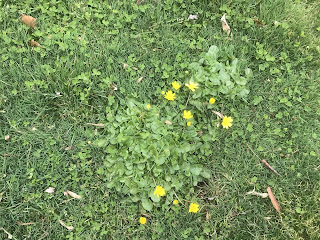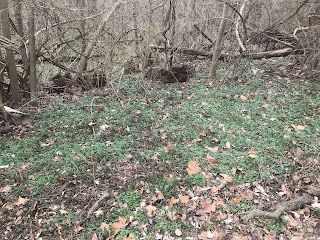 |
| Saucer Magnolia in full bloom |
We have entered the end of March and spring has definitely sprung. The tulips are growing bigger by the day, the daffodils have begun to bloom, the first flowering trees are showing beauty, and the spring time thunderstorm monsoons have once again graced our presence. Yes it is looking like a normal spring on the WHCC grounds, except for one tiny little thing.........can't put my finger on it.......oh yeah, we are in the midst of the biggest pandemic to hit this country in over a century! I have to steal a quote that our General Manager used the other day to describe the current situation. In the words of Ron Burgundy, "Boy, that escalated quickly. I mean that really got out of hand fast." Well that about sums it up. As I'm sure everyone can relate to right now our situation changes by the day. Currently we are continuing to accomplish grounds maintenance but we are spending more of our day sanitizing doorknobs, eating areas, equipment, carts, and computers. Luckily working outdoors makes it easier to practice physical distancing, but we are all getting accustomed to having hand sanitizer close by. Also, we are working closely with the golf professionals to lower the exposure risk for every golfer on the course. First we are raising the cups about an inch above the surface so when the ball hits the cup it is considered a sunk put and can be picked up. This will limit the possible virus exposure a golfer would have with the flag stick and inside the cup.
 |
| Raised cup on #18 green |
Other measures that are being utilized to reduce potential exposure are removing all the bunker rakes, the sand buckets located throughout the course, par 3 tee boxes, and all ball washers. Golf remains one of the best sports to play in these conditions especially if one walks and maintains a 6 foot distance from others.
Another way to beat the quarantine blues is to, simply, get outside. Take a walk and enjoy mother natures' spring-time beauty or work out in the garden. In the coming weeks the Country Club will be coming alive with blooms. Also, this may be a great time to start a home vegetable garden. Cool-season vegetables such as pees, broccoli, and lettuce can be planted now. Summer vegetables can be started from seed indoors and will be ready to plant outside by early May.
Being a plant enthusiast and thinking about the precautions that are being taken to combat Covid-19 disease, I am reminded of the disease triangle model that shows interactions between the environment, the host, and an infectious agent in both plants and humans. Take away one of these entities and the disease will not survive. As plant pathologists we are constantly referencing this triangle to maintain healthy turf, shrubs, trees and flowers. For example, rose black spot disease has to have a susceptible rose, the black spot bacteria, and a warm humid environment to cause infection. By planting a resistant variety, one of these items (the host) is taken away and the disease is suppressed. Similarly, the grounds department (and everyone else) is combating Covid-19 by killing the SARS-CoV-2 virus (the infectious agent) by sanitizing and hand washing, and practicing physical distancing (taking away the host) to limit the spread.
Hopefully, a hot summer environment may also help in destroying this virulent pathogen. For more information about the plant disease triangle
click here for an interesting article from Ohio State University.

Outside fighting the current pestilence the grounds department has been getting projects and maintenance accomplished. The gravel cart path that existed in between #11 green and #10 tee has been removed and replaced with new fescue sod. Also, sod was laid in other bare areas located throughout the course. The winter tree work has been completed. The stump grindings are being removed and replaced with soil and sod or seed. In addition, we put down over 1,000 lbs of fescue seed scattered throughout many rough areas and it is starting to germinate.
 |
| Excavation of #11 gravel path |
 |
| New sod installed on #11 |
 |
| Sod added to the bare area by #4 tee |
 |
| Stump grinding hole sodded |
 |
| Fescue seed starting to germinate in between #15 and #16 |
The irrigation system has been turned on for the season. We were lucky that most of the digging that was done to replace the main water line for the clubhouse caused minimal damage to the course irrigation system. Other issues that needed to be addressed such as replacing the defective vertical distribution board in the #7 satellite box, fixing broken sprinkler heads, and updating the Lynx irrigation system to the newer program have been accomplished.
 |
| Replacing the vertical distribution board |
 |
| Starting up the irrigation system |
The mowing operation has begun. Greens, tees, and fairways have been mowed multiple times and the mowing frequency is increasing. Soon we will be mowing greens daily. The far practice tee will open on April 1st and we have been mowing and fertilizing so it will be ready for play.
The landscape department has started the process of cleaning out beds, cutting down perennials and mulching. The daffodils and tulips are beginning to bloom.
 |
| Tulips blooming by the front of the clubhouse. |
 |
Freshly mulched bed behind #11 green with daffodils beginning to bloom.
The daffodils blooming a week later
|
 |
| Cornelian cherry dogwood blooming |
A tree that is very easy to spot this time of year is the
callery pear tree. They are native to Asia and were originally brought over because of their resistance to fireblight disease. They quickly gained popularity because of their gorgeous spring white blooms, beautiful fall color, and their ability to grow in tough environments. Originally considered sterile trees, over time, small fruits started to form and soon birds deposited the seeds throughout the landscape. Now callery pears are invasive and can be seen growing in woods and fields all over the tri-state- an example of a good tree gone bad!
(for more information read this article by Ohio State University)
 |
| A callery pear in bloom by the driving range. |
As the grass grows so does the spring time weeds.
Lesser celandine is an invasive early spring weed that is becoming much more common in the tri-state area. In the next couple of weeks the agronomy team will begin to apply herbicides to limit its spread.
 |
| Lesser celandine |
 |
| Lesser celandine taking over the forest floor by #4 tee area |
The Grounds Department will continue to march forward with springtime jobs as long as the current situation allows. Our hopes and prayers are that this pandemic is resolved soon. In the meantime listen to your mother-eat your vegetables, say your prayers, and wash your hands!
Brad Piecuch
Grounds Superintendent


















No comments:
Post a Comment
Note: Only a member of this blog may post a comment.